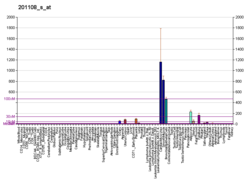Thrombospondine 1
La thrombospondine 1 est une protéine appartenant à la famille des thrombospondines. Son gène est THBS1 situé sur le chromosome 15 humain.
Rôles[modifier | modifier le code]
Elle a un rôle de mécano-récepteur : liée à l'IAP (« integrin associated protein »), sa conformation se modifie en cas de flux sanguin turbulent[5], activant le NOX1[6], modulant par ce biais la vasodilatation des vaisseaux. En particulier, le complexe THBS1-IAP contribue au mécanisme d'une hypertension artérielle pulmonaire[7]. Elle favorise la rigidification vasculaire[8].
Elle a également une action anti-angiogenèse et permet l'activation du TGF bêta[9]. Elle est d'ailleurs l'un des principaux activateurs de ce signal[10]. Elle favorise la formation d'un néo-intima et active les cellules musculaires lisses vasculaires[11].
Son expression est augmentée en cas d'ischémie des membres inférieurs[12].
Elle favorise la cicatrisation ainsi que la fibrose[13].
Notes et références[modifier | modifier le code]
- GRCh38: Ensembl release 89: ENSG00000137801 - Ensembl, May 2017
- GRCm38: Ensembl release 89: ENSMUSG00000040152 - Ensembl, May 2017
- « Publications PubMed pour l'Homme », sur National Center for Biotechnology Information, U.S. National Library of Medicine
- « Publications PubMed pour la Souris », sur National Center for Biotechnology Information, U.S. National Library of Medicine
- Freyberg MA, Kaiser D, Graf R, Buttenbender J, Friedl P, Proatherogenic flow conditions initiate endothelial apoptosis via thrombospondin-1 and the integrin-associated protein, Biochem Biophys Res Commun, 2001;286:141–149
- Csányi G, Yao M, Rodríguez AI et al. Thrombospondin-1 regulates blood flow via CD47 receptor-mediated activation of NADPH oxidase 1, Arterioscler Thromb Vasc Biol, 2012;32:2966–2973
- Rogers NM, Sharifi-Sanjani M, Yao M et al. TSP1-CD47 signaling is upregulated in clinical pulmonary hypertension and contributes to pulmonary arterial vasculopathy and dysfunction, Cardiovasc Res, 2017;113:15–29
- Kim CW, Pokutta-Paskaleva A, Kumar S et al. Disturbed flow promotes arterial stiffening through thrombospondin-1, Circulation, 2017;136:1217-1232
- Mustonen E, Ruskoaho H, Rysä J, Thrombospondins, potential drug targets for cardiovascular diseases, Basic Clin Pharmacol Toxicol, 2013;112:4–12
- Crawford SE, Stellmach V, Murphy-Ullrich JE et al. Thrombospondin-1 is a major activator of TGF-beta1 in vivo, Cell, 1998;93:1159–1170
- Moura R, Tjwa M, Vandervoort P, Cludts K, Hoylaerts MF, Thrombospondin-1 activates medial smooth muscle cells and triggers neointima formation upon mouse carotid artery ligation, Arterioscler Thromb Vasc Biol, 2007;27:2163–2169.
- Favier J, Germain S, Emmerich J, Corvol P, Gasc JM, Critical overexpression of thrombospondin 1 in chronic leg ischaemia, J Pathol, 2005;207:358–366
- Sweetwyne MT, Murphy-Ullrich JE, Thrombospondin1 in tissue repair and fibrosis: TGF-β-dependent and independent mechanisms, Matrix Biol, 2012;31:178–186








